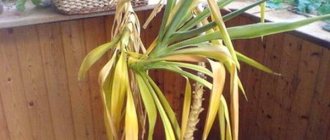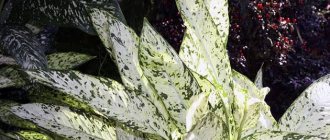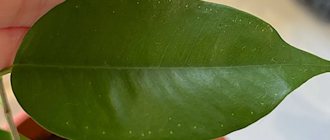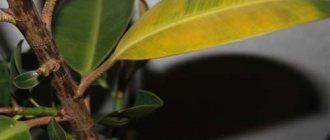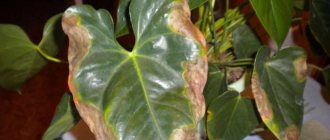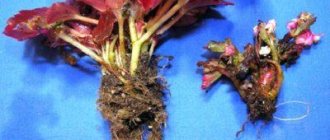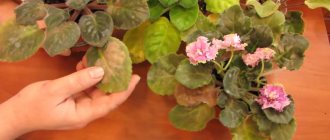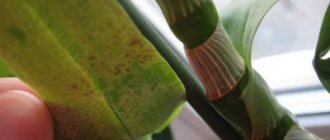Author: Elena N. https://floristics.info/ru/index.php?option=com_contact&view=contact&id=19 Category: Houseplants Published: May 19, 2014Last edits: January 11, 2021
- Chinese primrose / Primula chinensis
Botanical description
Primrose (lat. Primula) is a genus belonging to the family of Primrose plants, which has over 500 species of plants. Around the world, primroses grow in the Alps and throughout the rest of the world in temperate zones. The plant got its name due to its early flowering - almost immediately after the snow melts. Primulas are both annual and perennial rosette herbs. They bloom in pink, red and yellow flowers (other colors are also found). Flowers are usually collected in umbrella-shaped inflorescences, but can also grow one at a time. The fruit is expressed as a capsule. Plants are cultivated for their beautiful flowers; useful species are usually not grown indoors. Essential oils are obtained from the roots of spring primrose (medicinal) and large-chased primrose, which are used for medicinal purposes as an expectorant. Also, decoctions are prepared from the leaves and roots of primrose, which help with many diseases.
Primrose: home care and more
If you want garden primrose diseases and pests photos to decorate your apartment, then it is better to buy a species such as primrose obconica. This species has leaves with wavy edges and hanging on low stems. The length of these leaves can be about 10 cm. Primrose flowers are collected in inflorescences and have many color variations: white, red, purple, pink and light blue.
Primrose is loyal to air humidity. But if the air is too dry, the leaves will begin to dry out a little at the edges. It will be good to periodically spray the primrose with soft water.
Briefly about cultivation
- Flowering: Blooms in late April-early May.
- Lighting: bright diffused light.
- Temperature: 16-20 ºC, and during flowering – no higher than 16 ºC.
- Watering: moderate, through a tray, two days after the top layer has dried. During the flowering period, the substrate is watered as soon as the top layer dries.
- Humidity: normal for residential premises.
- Feeding: twice a season: in the twenties of June - with organic fertilizer, and at the end of the first ten days of August - with a solution of ammonium nitrate.
- Replant: every year after flowering.
- Substrate: a mixture of equal parts of humus, turf, deciduous soil and sand.
- Reproduction: seeds, cuttings and dividing the bush.
- Pests: aphids, spider mites.
- Diseases: gray rot, loss of buds, early yellowing leaves.
- Properties: the plant is poisonous!
Read more about growing primrose below.
Growing
Primroses can be grown both indoors and on windowsills. The main thing is that the plant is located away from heat sources - this will prolong its flowering.
Location
These plants will be comfortable in bright light, but exposure to direct sunlight is dangerous for them. Drafts are also destructive for them!
Temperature
Primroses tolerate low temperatures well, but not frost. The ideal temperature for them during the flowering period is 7-9 °C.
Watering
The substrate should be kept moist. Both lack and excess moisture are harmful to the plant.
Transfer
Replanting is done in the spring, after flowering, using a pot slightly larger than the previous one.
Primrose care at home
Lighting
Primroses grow best at home in bright rooms, but not in direct sunlight, so windows on the east and west sides are considered good. If there is enough light on the northern windowsill, then this place will be optimal.
Temperature
Homemade primrose needs to be kept cool (from 16 to 20 °C), and during flowering the temperature should not rise above 16 °C in order for it to last as long as possible. If the windows in the apartment are old, pots with primrose can be placed between the frames.
Watering
Indoor primrose needs moderate watering (a couple of days after the top layer of the earthen mixture has dried). During the flowering period, the plant is watered more often - immediately after the soil on the surface of the pot dries. For irrigation, use only settled water and do not get water on the leaves - this will cause them to rot. To avoid this, it is better to water the primrose plant through a tray or by immersion.
- How hippeastrums bloom
Spraying
Caring for primrose at home does not require special manipulations to increase air humidity - primroses are not demanding of it.
Top dressing
Primrose in a pot needs feeding only twice - on the twentieth of June (organic fertilizers are applied, you can use a solution of bird droppings) and on the tenth of August (0.1% aqueous solution of ammonium nitrate).
Trimming
It is necessary to pinch off or cut off flower stalks with faded flowers in order to stimulate the flowering of the next primrose flowers and not to take away the strength of the plant. You also need to get rid of yellowing primrose leaves.
Primrose transplant
Primroses are replanted annually after flowering. As can be understood from the few feedings, the substrate needed is not very nutritious. The best option would be a mixture of equal parts of sand, humus, turf and deciduous soil. You can grow primroses in a mixture of sand and peat (one part each) and three parts compost. Soft-leaved primrose needs less acidic soil, so the substrate for it is composed of sand, turf and coniferous soil (one part each) with the addition of two parts of deciduous soil.
Dividing the bush
Primroses can be propagated after flowering has ended. Before dividing the plants, they need to be moved to a shaded place and watered periodically, just so that the soil does not dry out. When the stems begin to grow, the bushes are carefully removed from the pot and divided into 2-3 parts, after which they are planted in boxes at a shallow depth. The container with young bushes is covered with glass and placed in a warm room with bright, diffused light. When the primroses get stronger, they are transplanted into individual pots (9 cm in diameter), and after another 30-40 days - into larger pots (13 cm in diameter). Old leaves will need to be trimmed, and the plants will need to be fed once every two weeks with a solution of mineral fertilizers diluted by half.
Propagation by cuttings
Primroses are usually propagated this way if the plant has only one rosette. You need a shallow container into which you need to pour a small layer of peat, and on top - sand, in a layer of 2 cm. One leaf of the plant is separated along with the petiole and bud. The leaf plate itself must be cut in half with a sharp knife so that there are no torn edges. The primrose cuttings are planted in the prepared soil at an angle to a depth of 1 cm, the bud should “look” up. The container with the cuttings is placed in a room with a temperature of about 18 °C, the soil is regularly moistened. Within 80-100 days, the cuttings should take root, after which they are transplanted into individual pots with a substrate of deciduous and humus soil, with the addition of sand (4: 2: 1). By this time, the seedlings should have at least 3 leaves. In about six months the primrose will bloom.
- Reproduction and cultivation of sansevieria
Growing from seeds
Primrose from seeds is grown depending on the species. For example, conical primrose seeds are sown in mid-to-late spring, and soft-leaved primrose seeds are sown in early to mid-summer. To propagate primrose by seeds, the substrate is made up of equal parts of deciduous soil and sand. The seeds are sown on the surface, the soil is moistened with a spray bottle, covered with glass and placed in a bright place, protected from direct rays, with a temperature of about 18 °C. The container is ventilated from time to time and the soil is moistened. In about a week and a half, shoots should appear. A month after planting, the seedlings are transplanted for the first time, and the second time – another month later. After another month, the seedlings are planted in individual 9-centimeter pots, and then again in a larger pot. It usually takes about six months from sowing to flowering.
Virulence
After working with the plant, you should wash your hands, since contact with primrose leaves can cause skin irritation. For people with sensitive skin, it is better to work with the plant wearing rubber gloves.
Houseplants, garden flowers, growing vegetables, garden care
- 16-01-2018, 07:28
- 93896
Indoor plants grow well at home if they receive everything they need - light, water, warmth, humidity and nutrients. The conditions for keeping it at home largely depend on the origin of the chosen plant; for example, tropical crops require warmth, high air and soil humidity, while cacti, on the contrary, are accustomed to bright sunlight and drought.
When growing houseplants in pots, you must follow individual care rules for each species, which are based on creating the most similar conditions for a given plant to its natural environment. Violation of this harmony leads to diseases of the flower planted in the pot.
Diseases and pests
Primrose leaves turn yellow. This can be caused by many reasons: too dry air in the room or increased air temperature. It can be caused by prolonged waterlogging of the soil, watering with soft water or excessive fertilizing. For the same reasons, the roots may turn brown.
Primrose fell ill with gray mold. To prevent this from happening, water should not get on the leaves, and primrose should not be grown in a room with high air humidity. The soil surface should dry out slightly between waterings.
Primrose flowers fade quickly. This happens if primrose blooms at air temperatures above 16 °C (optimally 12-14 degrees Celsius).
Primrose sheds its buds. The reason is too high an air temperature, insufficient watering or too dry air.
Primrose pests. Primulas most often suffer from aphids or spider mites, and growing in high temperatures and dry air increases the likelihood of damage.
- Parsley: growing on the windowsill and in the garden
Why does my primrose turn yellow and the tips of its leaves dry out?
Reason: low air humidity and high room temperature. Experts recommend that in winter, if the flower is on a windowsill, it should be fenced off from heating devices with a small barrier made of plastic film, 50 cm high. It is also necessary to carry out frequent spraying (once a day in summer, 2-3 times a week in winter). The leaves dry out if the primrose experiences a lack of moisture. It needs to be watered after the top layer of soil has dried.
Kinds
Chinese primrose / Primula chinensis
An herbaceous perennial, reaching a height of about 30 cm. The leaves are petiolate, collected in a rosette, rounded-heart-shaped, up to 15 cm long, the edges of the leaf blade are serrated. The inflorescence is umbellate. The flowers reach 4 cm in diameter, come in pink, red, white or orange, and the petals can be wavy. In order for the plant to bloom next year, after flowering it is necessary to arrange an artificial dormant period.
Primula kewensis
The representative of the species is a herbaceous perennial with rosette leaves. The leaves are petiolate, up to 20 cm long, have a rounded heart-shaped shape, with a jagged edge and a white coating on the upper side of the leaf blade. The umbrella-shaped inflorescence rises on a 30-centimeter peduncle. The flowers are small (about 1 cm in diameter), have a pleasant aroma, and are yellow in color.
Primrose soft or soft-leaved / Primula malacoides
This species is native to China. A herbaceous annual, reaching a height of just under 0.5 m. The leaves are rosette, petiolate (petiole up to 8 cm), can be oval or heart-shaped, up to 20 cm long, the edge of the leaf is serrated. There may be several peduncles, without leaves, with 3-6 whorls of 10-20 flowers each. The flowers are fragrant, can be pink, white or red, with a yellow spot in the throat. The flowering period occurs in mid to late winter.
Primula obconica / Primula obconica
Another Chinese species, but a herbaceous perennial, reaching a height of just over 0.5 m. The leaves are petiolate (petiole up to 10 cm), pubescent, rounded (the base of the leaf is heart-shaped), rosette, reaching 10 cm in length, the edge of the leaf is wavy. The peduncle reaches 20-25 cm, without leaves. The inflorescence is umbellate. The flowers are fragrant and come in dark red, blue, white or pink. There are varieties that do not cause allergies.
Common primrose / Primula vulgaris
Also found under the name stemless primrose (Primula acaulis). This species has oblong, wrinkled leaves. The flowers are quite large, come in red, yellow or blue, and grow from the center of a leaf rosette. A large number of hybrids have been bred in culture.
Garden primrose - care and reproduction.
Primroses or primroses are a group of perennial, herbaceous plants that can be either evergreen or deciduous. Most primroses are low-growing, with leaves collected in rosettes. The colorful flowers usually grow in clusters and come in a wide variety of shapes, although some species bear only one flower per stem. Many primroses have a delightful aroma.
In nature, primroses are found in many places, including rugged alpine mountains, rocky slopes, river banks, dry and wet forests, wet meadows, swamps and even subtropical forests. Although there are about 500 varieties of primroses, only certain groups of these flowers are easy to grow in the garden. All primroses prefer fertile soil rich in organic matter. The soil pH should range from slightly acidic to slightly alkaline. A good potting mix should be 2 parts organic matter, 2 parts topsoil and 1 part coarse sand. Some varieties such as Primula Angustifolia may require more sand as they require good drainage.
Primroses prefer...
plantferm.ru
Primrose propagation
Primroses are propagated either by seeds or by dividing the bush. Reproduction occurs mostly in the summer, in June or July at home.
Over 3-4 years, the primrose bushes grow, and so that the new rosettes do not crowd each other, and the plant does not weaken its flowering, they are planted, dividing them into new bushes. It is preferable to do this in August, so that new plants have time to take root before the onset of cold weather.
Apart from division, primrose can be propagated by seeds and rooting of axillary shoots.
The optimal time for sowing seeds is from November to December, but in principle they can be sown all year round. For good germination, the crops should be kept at a temperature of 16 °C to 20 °C in conditions of high humidity and good light. If these requirements are met, shoots should appear in 10-12 days, then the air temperature and humidity can begin to be gradually reduced. In March-April, the seedlings should be transplanted into small pots and then transplanted into open ground. It must be remembered that primrose seedlings, when compared with plants taken by other propagation methods, grow more slowly and require increased care.
If the plant has one rosette of leaves or a weak root system that does not allow the bush to be divided, it is propagated by rooting axillary shoots. To do this, by separating the petiole of the page with a bud and part of the shoot at the base of the root collar and shortening the leaf blades by half, the cutting is planted in a planting mixture of deciduous soil and coarse river sand. In order for such a cutting to take root, you need to keep it in a bright room, but away from direct sunlight, at a temperature of 16 °C to 18 °C and moderate soil moisture. Over time, such buds will give rise to shoots with 3-4 leaves. They should be planted in 7-9 cm pots, and then, when favorable weather conditions occur, transplanted into open ground.


